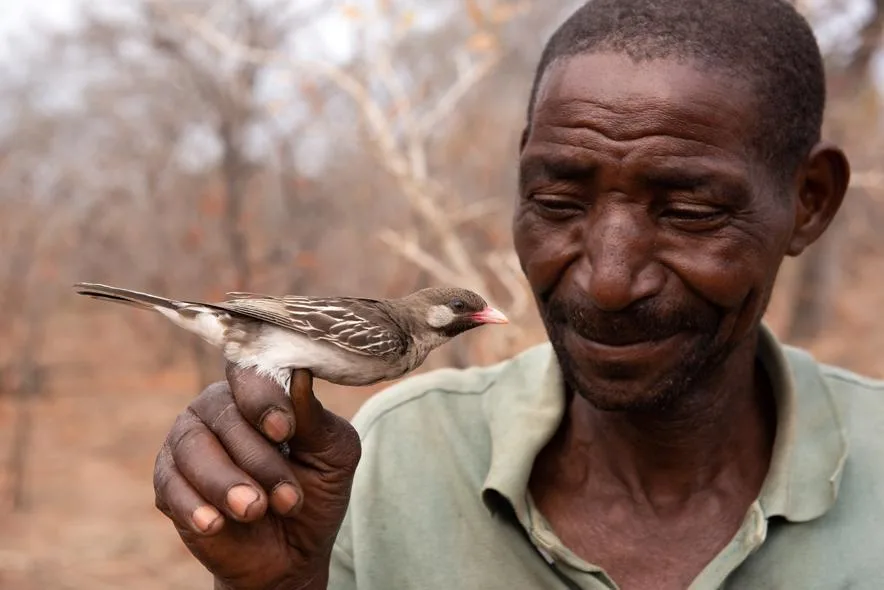
Imagine a feathered whisper guiding you through sun-dappled acacia groves, a secret pact between human and bird that has sustained generations. In the vast savannas of Kenya, this isn’t a fairy tale—it’s the remarkable reality of the honeyguide bird and the local tribes who call it partner.
As a testament to humanity’s deep-rooted harmony with nature, this mutualistic dance not only yields sweet rewards but embodies sustainable living at its most poetic. At Sidai Camp in Laikipia, guests are invited to step into this timeless ritual, forging their own connection with the wild.

The Call of the Wild: How the Honeyguide Works Its Magic
At the heart of this story is the greater honeyguide (Indicator indicator), a quirky bird with a love for beeswax—the fatty, calorie-rich prize it craves but can’t access easily. Picture this: As dawn breaks over the Kenyan bush, a Samburu or Maasai warrior pauses, ears attuned to the air. A sharp, insistent chit-chit-chit pierces the quiet—the honeyguide’s summons. These birds, ever opportunistic, have evolved to “recruit” humans, their unlikely allies in the quest for hives hidden high in thorny treetops.
The human responds with a distinctive call, a throaty “brrr-hm” or whistled trill unique to their community, signaling readiness. It’s no random chirp; studies show honeyguides recognize and prefer these local dialects, swooping closer to those who “speak their language.” Once engaged, the bird takes flight, darting ahead in a zigzag pattern—leading, pausing, calling again—to the bee colony. The journey might span kilometers, a patient game of follow-the-leader through grasslands teeming with wildlife.
Upon arrival, the real artistry unfolds. The hunter, armed with a long pole, bark torch, and unyielding resolve, kindles smoke from dry grass and dung. Billowing clouds subdue the furious swarm, allowing access to the hive. With deft hands, they extract combs dripping with golden honey, a vital protein source for the tribe. But here’s the grace note: the wax-laden remnants are deliberately left behind, a feast for the honeyguide, whose specialized gut digests it effortlessly. In this exchange, no one loses; everyone thrives. The bird gets its delicacy, the humans their harvest—and the ecosystem remains untouched.
This isn’t mere folklore. Among Kenya’s Boran people in the north or the Ndorobo in the south, such hunts have persisted for centuries, a cultural thread woven into oral traditions and seasonal rhythms. Even in coastal communities like the Awer, the practice endures, with birds guiding hunters to wild nests year after year.
Sustainability in Every Drop: Living as Stewards of the Land
In an era of industrial beekeeping and habitat loss, the honeyguide partnership shines as a beacon of sustainability. Local tribes harvest selectively, taking only what’s needed from wild colonies, preserving bee populations and forest health. Smoke, not chemicals, calms the bees; tools are simple, leaving minimal footprint. This low-impact method contrasts sharply with modern monocultures, fostering biodiversity where wildflowers bloom unchecked and pollinators flourish.
For Kenya’s pastoralists—Maasai, Boran, and beyond—this symbiosis mirrors their broader ethos: working withnature, not against it. Honey isn’t just food; it’s medicine, barter, and ritual, harvested in tune with the land’s cycles. Elders pass down knowledge of bird calls and hive signs, ensuring resilience against climate shifts. By sharing the bounty, humans honor the bird’s role, reinforcing a worldview where every creature has its place. It’s a quiet revolution: sustainable livelihoods that protect the very wilderness sustaining them.
Join the Dance: Honey Hunting at Sidai Camp
What if you could witness—or even join—this ancient ballet? At Sidai Camp, such wonders are within reach. Here, guests rise before the sun to venture out with local guides, ears pricked for the honeyguide’s call.
The experience begins with a briefing on the ritual’s lore, then a bush walk where your guide—perhaps a warrior with stories etched in his scars—teaches the responding trill. If fortune smiles and a honeyguide appears, you’re led through the dawn-lit plains, hearts pounding with anticipation. At the hive, under expert supervision, you might help tend the smoke or taste the fresh, floral honey straight from the comb—wild, unfiltered, alive. It’s hands-on immersion: learn to read the bird’s flights, understand the tribe’s sustainable codes, and leave wax as gratitude.
These outings aren’t just adventures; they’re bridges to understanding. Share a meal of honeycomb with your hosts, hear tales of the land’s spirits, and return transformed, honey-sweet memories in tow. Sidai Camp curates these encounters responsibly, supporting community-led conservation and ensuring every step treads lightly.
Ready to heed the bird’s whisper? Book your stay at Sidai Camp and let the wild lead the way. The honey awaits—and so does the harmony.








